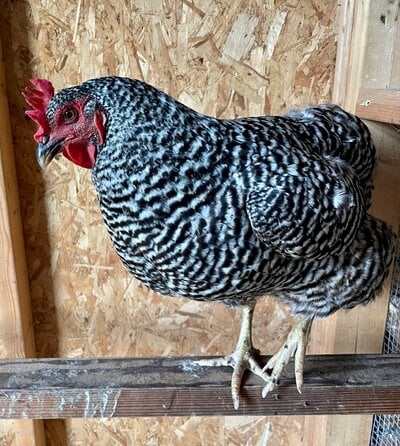lebanonfarmstead
Hatching
Hi All,
I would greatly appreciate any guidance on how to diagnose my hen's health issue properly. I noticed yesterday my one-year old barred rock was fighting with another hen (welsummer) while they were free-ranging yesterday, which is very unusual. The welsummer has mild bumblefoot which I treated again, and then checked out the barred rock. She had poopy bottom so I gave her a bath to clean her up. The poop that was stuck on was normal greenish/brown with a little white mixed in. Vent looked totally normal, no discharge. While bathing her I noticed her abdomen was swollen and warm to the touch. After doing hours of research I was convinced it was water belly, although her comb is red, not blue, she doesn't have any breathing issues, her belly is pale, not red. After watching videos and more research I tried to drain the fluid with a syringe. On two attempts, nothing came out. Today, she went into the nesting box but did not lay an egg. I don't know if she laid an egg yesterday. She is free ranging normally, but I can tell her running is off because she's uncomfortable/swollen. Her eyes are bright and clear. Her crop was normal last night and again this morning. I tried to give her a tums yesterday and she only about half a tablet. I don't know if it is truly water belly or if it's some other oviduct issue. When I put the 18 gauge needle in on her right side below her vent, I put it about an inch or so. Could it be that I didn't put the needle in far enough which is why no fluid came out? Looking for any guidance or suggestions on next steps. Thanks everyone.
I would greatly appreciate any guidance on how to diagnose my hen's health issue properly. I noticed yesterday my one-year old barred rock was fighting with another hen (welsummer) while they were free-ranging yesterday, which is very unusual. The welsummer has mild bumblefoot which I treated again, and then checked out the barred rock. She had poopy bottom so I gave her a bath to clean her up. The poop that was stuck on was normal greenish/brown with a little white mixed in. Vent looked totally normal, no discharge. While bathing her I noticed her abdomen was swollen and warm to the touch. After doing hours of research I was convinced it was water belly, although her comb is red, not blue, she doesn't have any breathing issues, her belly is pale, not red. After watching videos and more research I tried to drain the fluid with a syringe. On two attempts, nothing came out. Today, she went into the nesting box but did not lay an egg. I don't know if she laid an egg yesterday. She is free ranging normally, but I can tell her running is off because she's uncomfortable/swollen. Her eyes are bright and clear. Her crop was normal last night and again this morning. I tried to give her a tums yesterday and she only about half a tablet. I don't know if it is truly water belly or if it's some other oviduct issue. When I put the 18 gauge needle in on her right side below her vent, I put it about an inch or so. Could it be that I didn't put the needle in far enough which is why no fluid came out? Looking for any guidance or suggestions on next steps. Thanks everyone.




